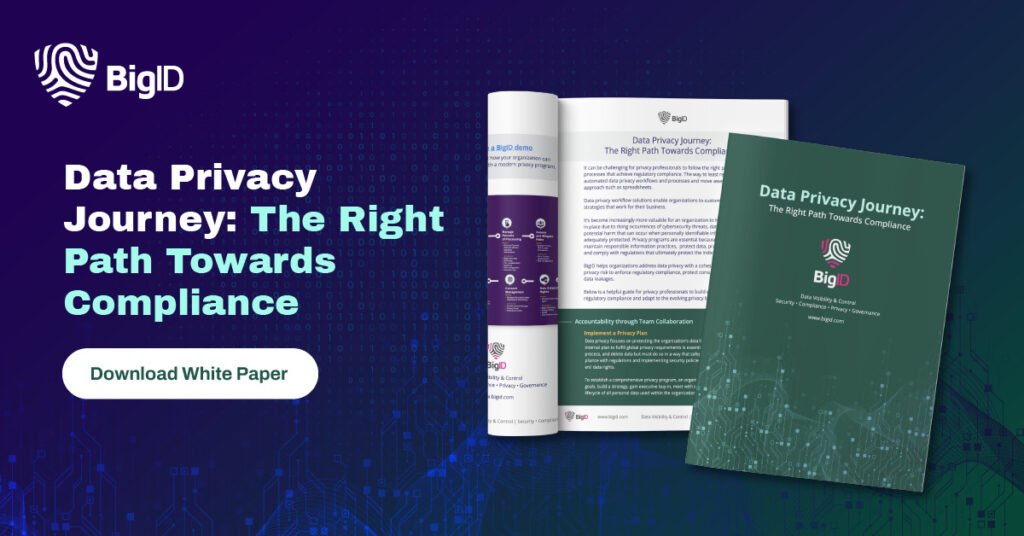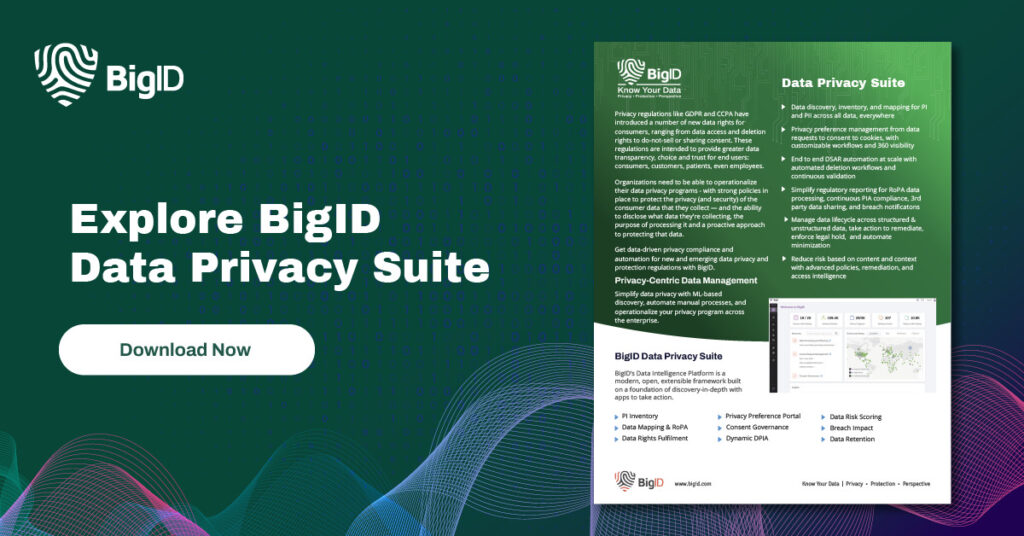What is privacy engineering?
Privacy engineering refers to the practice of incorporating privacy principles and measures into the design, development, and implementation of technology systems, processes, and practices to ensure the protection of individuals’ privacy rights and data. It involves considering privacy as a fundamental aspect of system design, rather than an afterthought or add-on.
The goal of privacy engineering is to create privacy-aware and privacy-preserving solutions that uphold individuals’ privacy rights and promote trust, transparency, and accountability in the use of personal data. Privacy engineering involves various techniques, tools, and best practices to proactively address privacy concerns and risks, such as data collection, storage, processing, sharing, and disposal, while adhering to applicable laws, regulations, and industry standards.
Moving beyond compliance
Privacy engineering isn’t just about privacy regulations— the primary purpose is to proactively protect individuals’ privacy rights and ensure the responsible and ethical handling of personal data throughout the entire lifecycle of technology systems, processes, and practices.
Privacy engineering focuses on incorporating privacy principles, measures, and best practices into the design, development, and implementation of technology systems and processes to minimize privacy risks, protect sensitive data, and prevent potential privacy breaches. It aims to embed privacy into the core functionalities, data flows, user interfaces, and security measures of systems and processes to ensure that privacy is respected by default and by design.
While compliance with privacy regulations is an important consideration in privacy engineering, it is not the sole purpose. Privacy engineering goes beyond mere compliance and strives to establish a privacy-centric mindset and culture within an organization, where privacy is considered a fundamental aspect of technology design and operation, and individuals’ privacy rights are respected proactively.
Privacy Engineering vs Privacy-by-Design
Privacy engineering and privacy-by-design are related concepts but are not exactly the same. While they share similar principles and goals, they have some nuanced differences.
Privacy engineering
Privacy engineering refers to the practice of incorporating privacy principles and measures into the design, development, and implementation of technology systems, processes, and practices. It involves proactively addressing privacy concerns and risks throughout the entire lifecycle of a system or process, from design to deployment and maintenance, to ensure the protection of individuals’ privacy rights and data. Privacy engineering involves using various techniques, tools, and best practices to embed privacy into the design and operation of systems, processes, and practices, taking into consideration factors such as data collection, storage, processing, sharing, and disposal, as well as compliance with applicable laws, regulations, and industry standards.
Privacy-by-design
On the other hand, privacy-by-design (PbD) is a specific approach or framework for building privacy into the design of systems or processes from the outset. PbD was originally proposed by Dr. Ann Cavoukian, the former Information and Privacy Commissioner of Ontario, Canada. PbD emphasizes the integration of privacy principles and measures into the design and architecture of systems or processes, rather than as an afterthought or add-on. It involves embedding privacy into the system’s core functionalities, data flows, user interfaces, and security measures, with the aim of proactively protecting privacy by default and by design.
In essence, privacy engineering is a broader concept that encompasses various privacy practices, including privacy-by-design, as part of a holistic approach to building privacy into technology systems and processes. Privacy-by-design, on the other hand, specifically refers to the approach of integrating privacy into the design and architecture of systems or processes as a proactive measure to protect individuals’ privacy rights. Both privacy engineering and privacy-by-design are aimed at promoting privacy-aware and privacy-preserving solutions, but privacy engineering is a more encompassing term that can include various methodologies, frameworks, and practices, of which privacy-by-design is one.

Understanding the role of a privacy engineer
A privacy engineer is a professional who specializes in ensuring that privacy is built into the design and operation of systems, applications, and processes within an organization. Their role is vital to business operations and leadership for several reasons:
- Privacy Compliance: Privacy engineers play a critical role in helping organizations comply with privacy laws, regulations, and standards. They ensure that data collection, storage, processing, and sharing practices align with applicable privacy requirements, such as the General Data Protection Regulation (GDPR), California Consumer Privacy Act (CCPA), and other global privacy laws. Compliance with privacy regulations is crucial to avoid legal liabilities, financial penalties, and reputational damage to the business.
- Data Protection: Privacy engineers are responsible for implementing technical measures to protect sensitive data from unauthorized access, use, and disclosure. They design and implement encryption, authentication, access controls, and other security mechanisms to safeguard personal information and maintain confidentiality. Data breaches and leaks can result in severe consequences for organizations, including financial losses and loss of customer trust, making data protection a crucial aspect of business operations.
- Privacy by Design: Privacy engineers ensure that privacy is embedded into the design and development of systems and applications from the beginning, following the principle of Privacy by Design. They work closely with software developers, product managers, and other stakeholders to incorporate privacy best practices into the entire development lifecycle. This proactive approach helps organizations mitigate privacy risks, identify and address potential privacy issues early, and reduce the cost of remediation.
- Risk Management: Privacy engineers assess privacy risks associated with business operations and provide recommendations to mitigate those risks. They conduct privacy impact assessments (PIAs), privacy audits, and risk assessments to identify vulnerabilities and gaps in privacy practices. By managing privacy risks effectively, organizations can avoid reputational damage, financial losses, and legal liabilities.
- Trust and Reputation: Privacy is a fundamental right, and organizations that prioritize privacy demonstrate a commitment to respecting their customers’ privacy and building trust. Privacy engineers help organizations establish a positive reputation by designing and implementing privacy-preserving practices. This can lead to increased customer loyalty, improved brand reputation, and a competitive advantage in the market.
Privacy engineering implementation steps
Here are some key steps steps to implementing privacy engineering:
- Assess Privacy Risks: Conduct a comprehensive privacy risk assessment to identify potential privacy risks and vulnerabilities in your organization’s data processing activities. This can involve reviewing data flows, data collection practices, data storage and processing systems, and third-party data sharing arrangements.
- Develop Privacy Policies and Procedures: Develop and implement clear and comprehensive privacy policies and procedures that align with applicable laws, regulations, and industry standards. These policies should outline how personal data is collected, used, shared, and protected, as well as the rights and choices individuals have regarding their data.
- Implement Privacy by Design: Incorporate privacy principles and measures into the design and development of technology systems, processes, and practices from the outset. This includes conducting privacy impact assessments (PIAs) for new projects or initiatives, implementing data minimization and purpose limitation principles, and considering privacy-enhancing technologies (PETs) such as data anonymization or encryption.
- Provide Privacy Training and Awareness: Educate employees and stakeholders about privacy best practices, data protection principles, and their roles and responsibilities in protecting personal data. This can involve providing privacy training sessions, creating awareness campaigns, and promoting a privacy-conscious culture throughout the organization.
- Establish Data Subject Rights and Consent Management: Implement processes and mechanisms to facilitate individuals’ exercise of their privacy rights, such as the right to access, rectify, delete, or restrict processing of their personal data. Additionally, establish a consent management system to ensure that individuals’ consent for data processing is obtained in a transparent and compliant manner.
- Conduct Regular Privacy Audits: Regularly review and audit your organization’s privacy practices to ensure compliance with privacy laws, regulations, and internal policies. This can involve conducting internal audits, engaging third-party auditors, or using automated tools to assess privacy compliance.
- Monitor and Respond to Privacy Incidents: Establish a process for monitoring and responding to privacy incidents, such as data breaches or privacy breaches. This includes having a data breach response plan in place, conducting investigations, notifying affected individuals and relevant authorities, and taking corrective actions to prevent similar incidents in the future.
- Continuously Improve Privacy Practices: Privacy engineering is an ongoing process, and it’s essential to continuously review, improve, and adapt your organization’s privacy practices as technologies, regulations, and business requirements evolve. Stay updated with changes in privacy laws, industry standards, and best practices to ensure that your organization’s privacy program remains effective and compliant.
Globally recognized privacy engineering standards
- General Data Protection Regulation (GDPR): GDPR is a European Union (EU) privacy regulation that sets out requirements for the protection of personal data of EU residents. It outlines principles such as data minimization, purpose limitation, and accountability, and requires organizations to implement technical and organizational measures to ensure privacy and data protection.
- ISO/IEC 27001: The ISO/IEC 27001 standard is a globally recognized information security management system (ISMS) standard that provides guidelines for organizations to establish, implement, maintain, and continually improve an information security management system. This standard includes requirements related to privacy and data protection, such as risk assessment, access control, encryption, and incident response.
- NIST Privacy Framework: The National Institute of Standards and Technology (NIST) Privacy Framework is a voluntary guideline that provides a risk-based approach to managing privacy risk. It provides a framework for organizations to manage privacy risks in a way that aligns with their business objectives, risk tolerance, and regulatory requirements.
- Privacy by Design (PbD): Privacy by Design is a set of privacy principles developed by Dr. Ann Cavoukian, the former Information and Privacy Commissioner of Ontario, Canada. PbD emphasizes the proactive inclusion of privacy in the design and operation of systems, applications, and processes, and focuses on embedding privacy as a core consideration from the outset of any project.
- APEC Privacy Framework: The Asia-Pacific Economic Cooperation (APEC) Privacy Framework is a set of principles and implementation guidelines for organizations to enhance privacy protections for cross-border data flows. It provides a framework for organizations to comply with privacy requirements while facilitating the free flow of information across borders.
BigID’s Approach to Privacy Engineering
BigID is an industry leading data discovery platform for privacy, security, and governance that provides organizations with tools and capabilities to help manage and protect sensitive data, comply with privacy regulations, and implement efficient privacy engineering practices. Organizations can leverage BigID in several ways to implement efficient privacy engineering:
- Data Discovery and Classification: BigID uses machine learning and advanced AI to automatically discover and classify sensitive data across various sources, such as databases, file systems, cloud storage, and data lakes. This helps organizations gain visibility into their data landscape and identify personal data, which is critical for privacy engineering. By accurately identifying and classifying sensitive data, organizations can effectively manage and protect it in accordance with privacy regulations.
- Data Mapping and Data Flow Analysis: BigID enables organizations to create data maps and visualize data flows to understand how personal data is collected, used, stored, and shared within their systems and applications. This helps organizations identify data flows that may pose privacy risks and enables them to implement appropriate controls to mitigate those risks. Understanding data flows is a fundamental aspect of privacy engineering, as it allows organizations to assess privacy risks and implement necessary measures to protect personal data.
- Automated Privacy Compliance: BigID provides automated workflows and assessments to help organizations streamline privacy compliance processes. It includes features such as automated assessments of data subject rights requests, automated data retention management, and automated privacy impact assessments (PIAs) and data protection impact assessments (DPIAs). These features help organizations efficiently manage privacy compliance requirements, reducing the manual effort and time required to meet regulatory obligations.
- Privacy Risk Management: BigID’ Privacy Impact Assessment enables organizations to identify and prioritize privacy risks based on factors such as data sensitivity, data exposure, and regulatory requirements. It includes features such as risk scoring, risk visualization, and risk reporting, which help organizations assess, manage, and monitor privacy risks in a systematic and efficient manner.
- Privacy Automation and Orchestration: BigID orchestrates automated workflows and orchestrates privacy-related tasks with ease. This includes features such as automated data subject rights fulfillment, automated data breach notification, and automated data deletion. Automation and orchestration can significantly improve the efficiency of privacy engineering practices, reduce manual errors, and enable organizations to respond to privacy requirements in a timely manner.
To see how BigID can increase the ROI of your privacy program—get a free 1:1 demo today.



